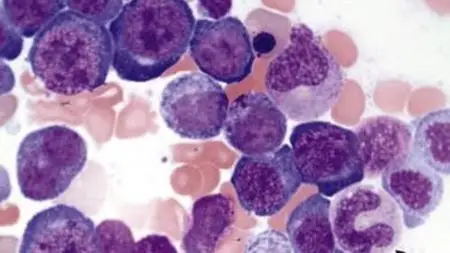Megaloblastic Anemia : Intro, Clinical Features & Management
Published 7/2023
MP4 | Video: h264, 1280x720 | Audio: AAC, 44.1 KHz
Language: English | Size: 595.35 MB | Duration: 0h 52m
Published 7/2023
MP4 | Video: h264, 1280x720 | Audio: AAC, 44.1 KHz
Language: English | Size: 595.35 MB | Duration: 0h 52m
Introduction, Etiology, Pathogenesis, Clinical features complications and management of Megaloblastic Anemia
What you'll learn
Megaloblastic Anemia : Definition
Megaloblastic Anemia : Causes
Megaloblastic Anemia : Pathophysiology and Symptoms
Megaloblastic Anemia : Complications and Treatment
Requirements
No prior experience needed
Description
Megaloblastic anemia is a form of macrocytic anemia, a blood disorder that happens when your bone marrow produces stem cells that make abnormally large red blood cells. Megaloblastic anemia is a type of vitamin deficiency anemia that happens when you don’t get enough vitamin B12 and/or vitamin B9 (folate). Healthcare providers treat megaloblastic anemia with vitamin B12 and B9 supplements.Your body needs a certain amount of healthy red blood cells to carry oxygen from your lungs to your tissues and back again. Like all blood cells, red blood cells start as stem cells in your bone marrow. Vitamin B12 and vitamin B9 help form red blood cells. Without enough vitamin B12 or vitamin B9, your body produces abnormal cells called megaloblasts.Megaloblasts don’t divide and reproduce like healthy cells, which means there are fewer red blood cells in your bone marrow. The abnormal cells are unusually large, so large they often can’t get out of your bone marrow to move into your bloodstream. And even if they do make their way into your bloodstream, the abnormal cells die earlier than healthy red blood cells. Combined, these factors reduce the number of red blood cells, causing anemia.Is megaloblastic anemia a serious illness?Megaloblastic anemia is caused in part by vitamin B12 deficiency. Left untreated, vitamin B12 deficiency can cause neurological issues, including memory loss, problems with balance and paresthesia, which is a sense of tingling or prickling in your arms and legs.How common is megaloblastic anemia?Megaloblastic anemia isn’t rare. Healthcare providers don’t have enough information to say exactly how many people may have megaloblastic anemia.
Overview
Section 1: Introduction
Lecture 1 Introduction
Section 2: Causes of Megaloblastic Anemia
Lecture 2 Causes of Megaloblastic Anemia
Section 3: Sources of vitamin B12 and folate and symptoms of their deficiency
Lecture 3 Sources of vitamin B12 and folate and symptoms of their deficiency
Section 4: Diagnosis of Megaloblastic Anemia
Lecture 4 Diagnosis of Megaloblastic Anemia
Section 5: Treatment of Megaloblastic Anemia
Lecture 5 Treatment of Megaloblastic Anemia
Section 6: Complications of Megaloblastic Anemia and prevention
Lecture 6 Complications of Megaloblastic Anemia and prevention
Medical students and allied medical professionals



